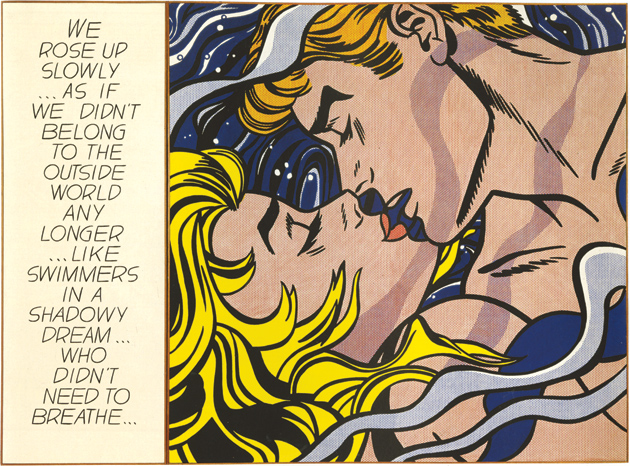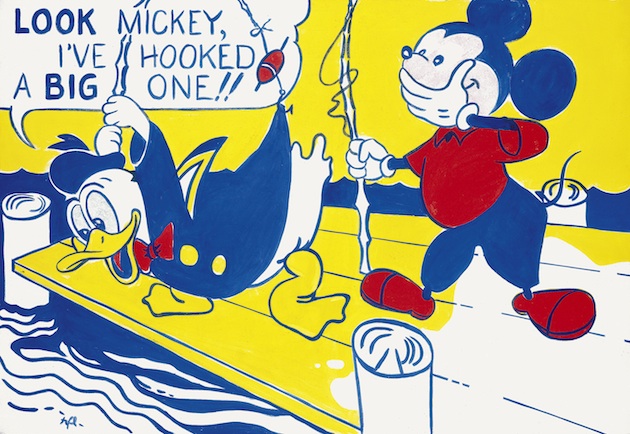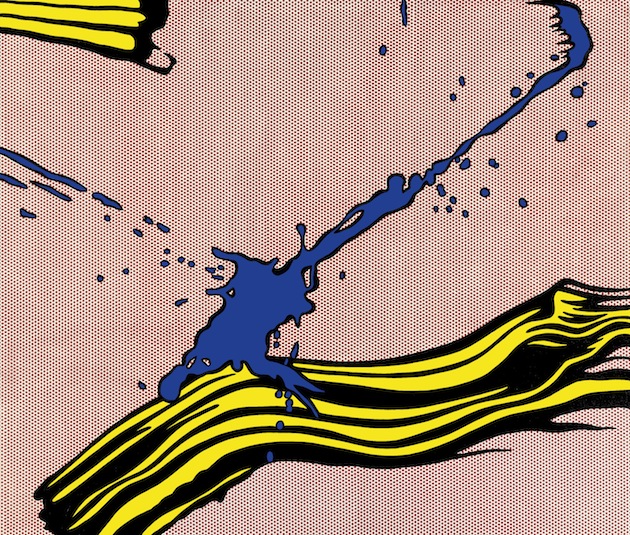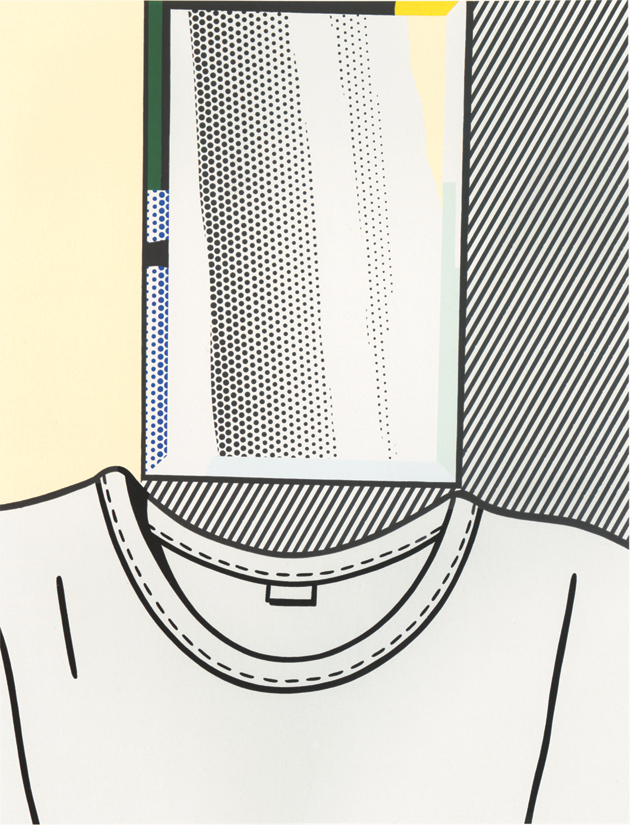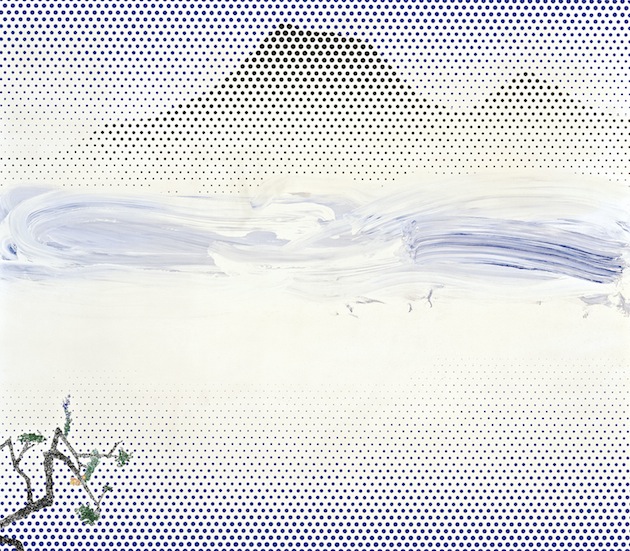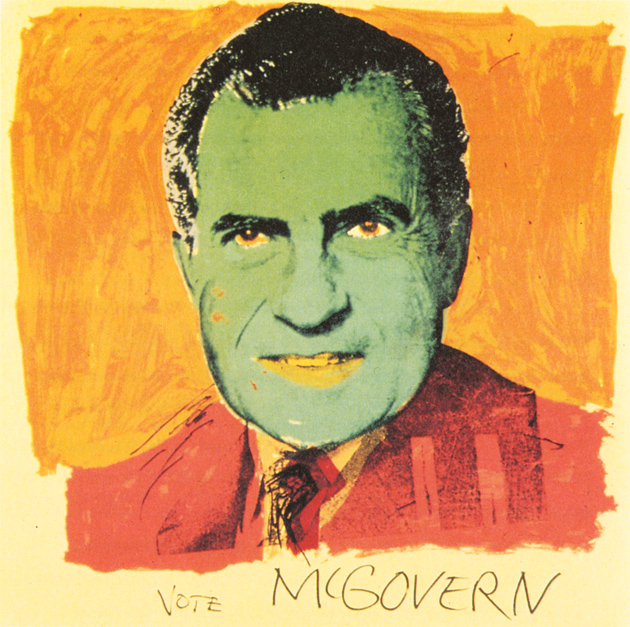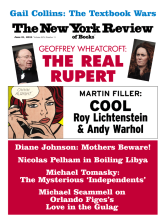1.
One of the more memorable encounters in the history of modern art occurred late in 1961 when the period’s preeminent avant-garde dealer, Leo Castelli, paid a call at the Upper East Side Manhattan townhouse-cum-studio of Andy Warhol, whose pioneering Pop paintings based on cartoon characters including Dick Tracy, the Little King, Nancy, Popeye, and Superman had caught the eye of Castelli’s gallery director, Ivan Karp, who in turn urged his boss to go have a look for himself. Warhol, eager to make the difficult leap from commercial artist to “serious” painter, decades later recalled his crushing disappointment when Castelli coolly told him, “Well, it’s unfortunate, the timing, because I just took on Roy Lichtenstein, and the two of you in the same gallery would collide.”
Although Lichtenstein, then a thirty-eight-year-old assistant art professor at Rutgers University’s Douglass College in New Jersey, was also making pictures based on comic-book prototypes—an example of wholly independent multiple discovery not unlike such scientific findings as calculus, oxygen, photography, and evolution—he and Warhol were in fact doing quite different things with similar source material, as the divergent tangents of their later careers would amply demonstrate. By 1964, Castelli recognized his mistake and added the thwarted aspirant to his gallery roster, though not before Warhol forswore cartoon imagery, fearful of seeming to imitate Lichtenstein, of whom he always remained somewhat in awe.
In fact, what Lichtenstein and his five-years-younger contemporary Warhol had most in common was being the foremost exemplars of Cool among their generation of American visual artists. The first half of the 1960s was the apogee of what might be termed the Age of Cool—as defined by that quality of being simultaneously with-it and disengaged, in control but nonchalant, knowing but ironically self-aware, and above all inscrutably undemonstrative.
Coolness (which was largely but not exclusively a male attribute) suffused American culture back then, from our supremely compartmentalized commander in chief, John Kennedy, to the action-movie star Steve McQueen, nicknamed “The King of Cool,” and from the middle-class cool of the TV talk-show host Johnny Carson to the far-out jazz trumpeter Miles Davis, whose LP album Birth of the Cool could serve as the soundtrack for that brief interlude before things suddenly turned hot toward the end of the Sixties. Coolness even had its own philosopher-theoretician, Marshall McLuhan, whose influential treatise Understanding Media (1964) codified comic books and television as “cool” means of communication.
Today, a quarter-century after Warhol’s death and fifteen years after Lichtenstein’s (in a hideous coincidence, both unexpectedly succumbed after what had been deemed routine hospital procedures), they remain the two Pop artists best known to the general public, if only in the most simplistic terms, with Warhol as the Campbell’s Soup guy and Lichtenstein as the cartoon guy. A pair of exhibitions that nearly overlapped this spring—a major one on Lichtenstein now at the Art Institute of Chicago before it travels internationally and a numerically comparable but physically more compact one on Warhol at the McNay Museum in San Antonio that was seen only there—offer telling contrasts between these two consummately cool customers.
The last comprehensive survey of Lichtenstein’s work took place in 1993, four years before he died at seventy-three. Mounted by the Guggenheim Museum and organized by the artist’s close friend Diane Waldman, that overview presented a body of work that, as fate would have it, turned out to be more or less complete. One might therefore have expected that there was by now little that had not already been seen from an artist who has been given more than 250 solo exhibitions.
Yet the Chicago retrospective includes several pieces unfamiliar even to experts, such as four little-known 1996 abstractions that combine Lichtenstein’s signature Ben-Day dots (a printing photo-reproduction method perfected by Benjamin Day Jr. in 1879) and closely spaced stripes of his Pop period with the Abstract Expressionist brushwork that he employed in his earliest paintings, then abandoned, but ultimately reembraced (in highly stylized form) as yet another useful tool in his well-stocked arsenal of techniques. This quartet of smallish mixed-metaphor canvases, which follows the exhibition’s knockout opening salvo—Look Mickey (1961), the painter’s first full-fledged Pop painting, which features the eponymous Disney mouse and Donald Duck in an antic face-off cribbed directly from a Golden Book borrowed from the Lichtenstein children—underscores the artist’s creative dilemma of how to advance beyond his reputation-making cartoon formula of the early Sixties.
Acutely concerned about repeating himself, Lichtenstein began to abandon dialogue and thought balloons as early as 1964, the same year that he tried to reintroduce the gestural flair he had suppressed in his flat, intentionally mechanical-looking Pop tableaux. He mimicked big, thick swaths of heavy impasto in his Brushstroke series (1965–1971), which he rendered in the same manner as his comic-book subjects: bold forms bordered in black outlines and filled in, as a coloring book might be, with even planes of smoothly applied primary-colored pigment.
Advertisement
Roy Fox Lichtenstein—who habitually signed his pictures with “rfl” in lower-case script—was born in Manhattan in 1923 and raised on the Upper West Side in a comfortable Jewish milieu. He attended the private Franklin School for Boys, avidly followed radio serials like Flash Gordon and The Green Hornet, and was entranced by his frequent visits to the 1939 New York World’s Fair, a futuristic architectural wonderland that clearly served as the inspiration for his sweetly nostalgic Modern series of paintings and sculptures (1966–1971), to which one room in the Chicago retrospective is devoted. Inspired by the angular geometries of Art Deco and sinuous curves of Streamlined Moderne, these sincere design homages are rooted in the stylish decor of the populist showplaces that epitomized the New York City of Lichtenstein’s youth. His polished brass Modern Sculpture with Velvet Rope (1968) would have been right at home as a crowd-control stanchion in the lobby of Radio City Music Hall.
An early fan of swing and jazz, as a teenager he took up the clarinet, started an amateur band, and was present at Benny Goodman’s historic Carnegie Hall concert in 1938. Music remained a recurrent if subliminal theme in Lichtenstein’s mature work. One of his most memorable prints (an important category of his oeuvre regrettably left out of the Chicago show, which does, however, include a roomful of his superb drawings) is the 1965 silkscreen The Melody Haunts My Reverie, his rendering of a dreamy blonde chanteuse singing that line from what many aficionados regard as the best popular song ever written, Hoagy Carmichael and Mitchell Parish’s “Stardust.”
After graduating from high school at sixteen, he studied painting at New York’s Art Students League under Reginald Marsh, in whose boisterous depictions of Minsky’s burlesque theater, Coney Island, and other scenes of populist pleasure Lichtenstein found a “very brassy, commercial quality” antithetical to the cool, declarative way in which he would later appropriate and address the commercial sphere. In 1940 he enrolled at Ohio State University, where he took courses in art, design, and draftsmanship until he was called up for military service three years later. His exceptionally precise graphic skills were recognized by the army, which sent him to France and Germany to draw maps for an engineering battalion of the invading Allied infantry.
Lichtenstein found his way to Cézanne and Lautrec exhibitions in London, bought a book on classical Chinese painting and some African masks, and when he got to Paris went to Picasso’s studio in the rue des Grands-Augustins but was too shy to ring the bell. Much of the young American’s coolness stemmed from his extreme shyness; his combat experiences, which he rarely discussed in later years, remained repressed memories, the case for so many survivors of the Big One, as the global conflict was referred to by its more reticent survivors.
Military combat, of course, reemerged prominently during Lichtenstein’s War and Romance period (1961–1966), but as with so much else he did, the artist’s bellowing US fighter pilots and beady-eyed U-boat Kapitäne are held at a safe emotional remove. We can thrill to their flyboy derring-do or sneer at their enemy treachery, but never do we detect a scintilla of the paralyzing fear that the twenty-one-year-old Lichtenstein must have felt at his post just a mile behind the front.
2.
Even though “Roy Lichtenstein: A Retrospective” is generally well selected and includes among its more than 160 pieces many that fully confirm the subject’s high reputation, it does not substantially alter what we already knew about this astonishingly prolific, technically adept, but only sporadically engaging virtuoso, whose output of some five thousand works was reviewed in depth by the show’s organizers, James Rondeau of the Art Institute and Sheena Wagstaff, who was recently named chairman of the Department of Modern and Contemporary Art at New York’s Metropolitan Museum.
Alas, there is an overall dryness to this show strikingly at odds with the giddy buoyancy of this artist’s work at its best, a perception attributable in large part to the drab installation. Set almost entirely against off-white walls (with the exception of one aubergine-painted gallery of drawings) and bathed in overly yellowish lighting at once harsh and dreary, the presentation might have benefited from backgrounds in a cool gray or some other harmonious tone. Lichtenstein restricted his palette to the primaries of red, yellow, and blue—the triad of the three-color commercial printing process—which along with black and white comprised the entire tonal range of his output until he began to introduce some fugitive touches of green in the 1970s, and occasionally a bit of orange, pink, or purple toward the very end of his career.
Advertisement
Another inhibiting factor is the works’ equally pervasive emotional reserve, not to say remoteness, consistent with the artist’s cool persona. Lichtenstein appeared well aware of his inability to connect with others. When I talked with him at length for my 1993 article on him,* the artist was unfailingly courteous, amiable, and candid, but also poignantly aware of his emotional limitations. Speaking of his relations with his two grown sons, he reported:
We can discuss anything unless its important…. I’m very interested in what they’re doing. But I have the feeling that I don’t get the really important things, the things that are really troubling them. That disturbs me. The kids have the same kind of shyness and hesitancy to bringing up anything emotional that I have.
This failure to connect with those around him feels palpable in Lichtenstein’s many paintings of crying women from the early Sixties, two prime examples of which are now on view in Chicago: Hopeless and Drowning Girl (both 1963). Those close to the artist at the time agree that these disturbing images were created in response to his disintegrating first marriage to the mentally troubled Isabel Wilson, from whom he first separated in 1961 and divorced in 1967.
But whereas Warhol’s Death and Disaster paintings (1962–1963) can prompt acute feelings of dread and anguish every time one sees them anew, Lichtenstein’s sobbing, tear-stained gals seem trapped in some hermetic space where they exist, as one of his dealers observed, “untouched and untouchable.” They are oddly lovely in their distress, like Betty Draper in Matthew Weiner’s Mad Men—a Lichtenstein fantasy girl if there ever was one—but no less unapproachable and thus ultimately uninvolving. In 1957, the critic Thomas B. Hess called Antonio Canova, Neoclassical sculptor of icily perfect marble nudes, “the erotic Frigidaire,” but that epithet might better be applied to Lichtenstein.
Leavening all this pseudo-distress is Lichtenstein’s marvelous, irrepressible sense of humor. Warhol seldom makes you smile; Lichtenstein rarely fails to. Many of Lichtenstein’s jests are art-world insider stuff, none more so than the comic-book canvas Masterpiece (1962), which depicts a pretty blonde exclaiming to the jut-jawed artist at her side: “WHY, BRAD DARLING, THIS PAINTING IS A MASTERPIECE! MY, SOON YOU’LL HAVE ALL OF NEW YORK CLAMORING FOR YOUR WORK!”
Lichtenstein’s enigmatic depiction of himself as a veritable cipher in his 1978 Self-Portrait (in which a vacant oblong mirror stands in for his face) is the standout in the gallery second only to the comic-book room as the strongest in the Chicago retrospective: the curators’ excellent selection from his Mirrors series (1969–1972). Though the critic Robert Hughes wrote in Time magazine in 1981 that “Lichtenstein’s work, always restrained, has by now reached what amounts to a trance of near-mechanical decorum. It scarcely trespasses on the world of feeling or lived experience,” he nonetheless also considered Mirrors as a lens through which to see their maker clearly:
They are the closest thing to the only kind of life drawing one can imagine Lichtenstein doing, an image of a blank white page. They acquire poignancy from the fact that they are empty. One gazes at them frontally, as at a real mirror, but nothing shows up in their superficial depths. The spectator is a phantom. These icy, imperturbable tondos and ovals may say more about the nature of Lichtenstein’s imagination than anything he has painted since.
Commentators including John Richardson and Wayne Koestenbaum have noted that the mirror is central to any understanding of Warhol. In his and Pat Hackett’s book Popism: The Warhol Sixties (1980), Warhol spoke of what reflective silver surfaces signified to him:
It was the perfect time to think silver. Silver was the future, it was spacy—the astronauts wore silver suits—Shepard, Grissom, and Glenn had already been up in them, and their equipment was silver, too. And silver was also the past—the Silver Screen—Hollywood actresses photographed in silver sets.
And maybe more than anything, silver was narcissism—mirrors were backed with silver.
But there was a world of difference between Warhol’s and Lichtenstein’s use of the mirror in their work. As Hughes acutely noted, peering into one of Lichtenstein’s faux looking glasses tells us nothing about ourselves though much about their maker’s inner opacity. As so often happens in Lichtenstein’s work, he reveals that there is nothing to reveal.
During his Early Pop (1961–1963) and Black and White (1961–1966) phases, Lichtenstein averred time and again that his choice of “dumb” subject matter—a golf ball, an automobile tire, a portable radio, a ball of twine—had nothing to do with meaning, but only registered the formal interest those prosaic objects held for him. He told us as much in one of his cleverest works ever, a highlight of the Chicago show: a meticulous enlargement of a black-and-white-marbled school copybook, nearly six feet tall, its familiar cover emblazoned “COMPOSITIONS.”
Similarly, Lou Reed’s 1967 song “I’ll Be Your Mirror,” written for the Velvet Underground (the rock band that Warhol managed from 1965 to 1967), could serve as the theme song for Warhol’s entire artistic enterprise. Soon after he dropped the cartoon subject matter he initially shared with Lichtenstein, Warhol turned to much tougher material than his friendly competitor ever ventured.
In a startling sequence of silkscreened canvases that drew on newspaper articles and wire service photos for their blunt veracity and gruesome immediacy, Warhol’s Death and Disaster series memorialized fatal car crashes, high-rise suicide leaps, electric-chair executions, accidental food poisonings, and other misfortunes of modern life. These harrowing pictures were followed by Warhol’s no-less-upsetting depictions of race riots, atomic bomb detonations, and the first Kennedy assassination. It has rightly been said that Warhol held up a pitiless mirror to contemporary American society and thereby captured the ingrained violence that had been there for all to see but had not seemed so visible until he copied it, cropped it, framed it, and put it up on a wall.
3.
The heart of the current Lichtenstein exhibition is a large gallery hung with sixteen of his best comic-book paintings of the early Sixties, including my personal favorite, We Rose Up Slowly (1964), which shows an enraptured romance-comic couple submerged underwater and just about to kiss. The square canvas that outlines these improbably gorgeous cartoon blondes is joined at the left to a second panel, one third the width of the first and inscribed with this breathless text against an off-white background: “WE ROSE UP SLOWLY…AS IF WE DIDN’T BELONG TO THE OUTSIDE WORLD ANY LONGER…LIKE SWIMMERS IN A SHADOWY DREAM…WHO DIDN’T NEED TO BREATHE…”
Lichtenstein’s propulsive close-up, with the couple’s enormous visages opposed at a dynamic diagonal and engulfed by swirling eddies and effervescent bubbles, brings to mind such upwardly spiraling Baroque constructs as Rubens’s The Rape of the Daughters of Leucippus (1618), in which the heads of the principal protagonists are almost a mirror image of those in this composition, though in the Pop pastiche the woman offers no resistance to her eager swain.
Lichtenstein certainly knew his art history, as is proven, almost ad nauseam, by the largest gallery in the Chicago show, which contains no fewer than twenty-seven works based on classic efforts by celebrated earlier artists, ranging from Monet and Matisse to Picasso and Mondrian, to name only a handful of his sources. However, the too-exhaustive checklist of paintings (and a few sculptures) in this imitative vein makes it feel as though Lichtenstein were laboriously working his way through a burdensome college syllabus rather than enjoying spiritual kinship with likeminded creative brethren.
Only a few of these diligent works convey any arresting originality, none more so than his deliciously droll Portrait of Madame Cézanne (1962), which replicates a black-and-white outline diagram of that picture by Erle Loran, whose 1943 book Cézanne’s Composition futilely tried to explain this most majestic and impenetrable of modern masters. Loran might just as well have been measuring the artist’s compliant wife for a new frock.
Even though the preternaturally industrious Lichtenstein still had four very productive years left following his 1993 Guggenheim retrospective, the concluding galleries of the Chicago show are an anticlimax after the haunting, thought-provoking Mirrors. In the handsome exhibition catalog, Wagstaff makes a spirited case for the artist’s penultimate Nudes series (1994–1997) as a transcendent breakthrough that in her estimation brings his career to a thrillingly open-ended conclusion.
However, Wagstaff’s impassioned argument is not at all supported by the works themselves, in which awkward unclothed female figures frolic and pose in a variety of stagy pin-up attitudes. These fantasy babes are doubly unerotic, not only because the outsized red or blue Ben-Day dots that cover their smoothly pneumatic bodies resemble contagious rashes, but even more so because they bring to mind nothing so much as inflatable sex dolls.
The survey closes with a selection of the artist’s final series, Landscapes in the Chinese Style (1996–1997), which were the subject of a show at the Gagosian Gallery in New York earlier this year, no doubt intended to capitalize on the increasing presence of high-rolling Chinese collectors in the blue-chip international art market. Based on Song Dynasty scroll paintings, which had fascinated Lichtenstein since his GI days, the twenty or so Chinoiserie canvases that he produced just before he died range from the ethereal Landscape in Fog (1996), in which he at last resolves his attempts at mixing Ben-Day dots (mountains and water) with Expressionistic brushwork (clouds and mist), to other examples that fail to rise above the level of Chinese restaurant decor.
The Chicago retrospective’s most inexplicable lapse is its shocking omission of Lichtenstein’s great 1989–1997 series of domestic interiors, not a single example of which is displayed. These imposing canvases (the largest is more than eleven feet high and thirty feet wide) depict modern living rooms in angular perspective, and often incorporate reflective mirrored walls, city views framed by large windows, and amusingly generic works of abstract art. There had been a monographic show of these works at Chicago’s Museum of Contemporary Art in 1999, but that cannot possibly justify their complete absence here. Lichtenstein’s Interiors were enthusiastically received by critics who correctly saw them as happy evidence of his return to top form after years of rigorously produced, technically proficient, but somehow irresolute work.
Those latter misfires included his Reflections series of the early 1990s, in which he revisited themes he had pursued earlier in his career but overlaid them with illusionistic slashes of mirrorlike patterning. That self-cannibalizing strategy paralleled Warhol’s equally weak late-career Retrospectives and Reversals series (1979–1980), in which he went back to his Marilyns and Mona Lisas of the Sixties and recycled them to little benefit as negative images.
What Lichtenstein and Warhol shared most in common was their inherent Cool—both in the 1960s definition of being hip and happening, but also in the larger sense of emotional inaccessibility. A major difference in the psychological makeup of both men can be readily distinguished in their contrasting artistic production. Lichtenstein, a secular Jew, was a good-looking, apparently happy, sexually satisfied heterosexual whose essential indifference to others often drove those closest to him crazy. Warhol, a devout Catholic wracked by insecurities about his appearance and tormented by religious guilt about his homosexuality, barely had any emotional reserves left for the vast and greedy entourage who lived off his fame and fortune. The underlying anxiety that gives Warhol’s best work its psychic charge has no equal in the placid worldview of Lichtenstein, whose crying women convey no greater menace than moths futilely beating their wings against a windowpane.
I exited “Roy Lichtenstein: A Retrospective” much enlightened but devoid of the euphoria I’d felt several months earlier when I saw “Andy Warhol: Fame and Misfortune,” at the McNay Art Museum in San Antonio. The 150 objects in that survey came entirely from the Andy Warhol Museum in Pittsburgh; the 160-plus works at the Art Institute are on loan from more than four dozen international sources—a sign of the borrowing clout wielded by a major institution like the Chicago museum as opposed to a small regional gallery like the McNay.
All the same, the Texas museum’s curator of post-1945 art, René Paul Barrileaux, did an admirable job in combing through the Warhol Museum’s holdings to find works that, if not necessarily the finest examples of their kind, were certainly up to the task of conveying his sharp interpretation of Warhol’s work. For all Warhol’s qualms about being beaten to the punch by Lichtenstein with their eerily similar cartoon paintings of 1961, there can be no doubt now that Warhol was a far more significant artist than his erstwhile rival for the backing of Leo Castelli. If Warhol had any contemporary peer it was Robert Rauschenberg, whose Combines (1954–1964)—stunning hybrids of painting and sculpture—would be enough from his vast oeuvre to earn him an equal place at the very top of the Pop pyramid.
“Andy Warhol: Fame and Misfortune” offered a penetrating examination of its subject’s deep-seated obsession, from childhood onward, with celebrity and publicity that he developed from precocious juvenilia—tracings of movie-star advertising endorsements and the like—to the mesmerizing silk-screened images he created in the early Sixties of megastars such as Marilyn Monroe, Elizabeth Taylor, and Elvis Presley, after he abandoned his highly lucrative practice as one of New York’s most-sought-after commercial artists to pursue the far less certain path of a high-style painter. Among the revelations of the McNay show was Barilleaux’s documentation that virtually every Warhol subject (at least until he began using a Polaroid camera in 1970) was based on photographs by others, even his universally recognized Campbell’s Soup cans. In contrast, scholars have shown that Lichtenstein almost always altered his comic-book sources to improve their compositional qualities.
Warhol, as the San Antonio exhibition reconfirmed, was a true believer and no ironist. Haunted by the specter of AIDS as a gay man in the 1980s, he was consumed by fears of an early death, which he in fact met although not from the cause he expected. (He was done in at fifty-eight by post-operative negligence after gall bladder surgery at New York–Presbyterian Hospital.)
The final irony for the ironist Lichtenstein is that he thought he would live forever, or at least as long as humanly possible. His mother died at ninety-five, and he told friends he felt good for a hundred, which no one doubted. He ate organic foods, maintained a trim figure, neither smoked, drank, nor used drugs, enhanced his youthful looks with cosmetic surgery, and enjoyed a vigorous extramarital sex life.
Yet he fell short of his centennial by twenty-seven years. In the summer of 1997, the otherwise healthy artist checked himself into Southampton Hospital, near his Long Island studio, with walking pneumonia. When his condition worsened he was transferred to New York University Medical Center in Manhattan, but he had contracted the antibiotic-resistant hospital-borne infection MRSA. Lichtenstein retained his wry humor to the very end, and as he was put into an oxygen tent his last words to his second wife, Dorothy, were, “Well, here I go,” uttered with the laconic cool of an Apollo astronaut ready to shoot for the moon.
This Issue
June 21, 2012
How Texas Messes Up Textbooks
Mothers Beware!
-
*
Martin Filler, “Pop’s Granddad,” Vanity Fair, August 1993. ↩


